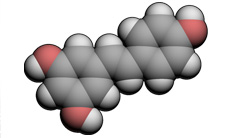







Hydroxystilbene molecule
Some of the more efficient pigment lightening flavonoid subcategories are the hydroxystilbene compounds, derived from natural products found in oriental herbal medicines.
There are more than 30 stilbene and stilbene glycosides with a structural skeleton comprised of two aromatic rings linked by an ethylene bridge. Commonly studied hydroxystilbene products include resveratrol (3,4’,5 trihydroxystilbene), its isomer oxyresveratrol and methoxylated or glycosylated analogs piceid-glucoside, rhapontigenin and rhaponticin.
The number and position of hydroxyl substituents of hydroxystilbene compounds seem to play an important role on the inhibition of tyrosinase activity. However, glycosylated hydroxystilbene compounds such as piceid, the glycoside of resveratrol at position 3, exhibit decreased tyrosinase inhibition compared to the parent compound. In all cases, tyrosinase inhibition is reversible and in turn requires a high concentration of hydroxylated stilbenes within melanocytes.
Resveratrol, a commonly studied hydroxystilbene, is found in red wine and displays free radical scavenging, anticancer and anti-inflammatory activities. Some data attribute resveratrol depigmenting affect to its ability to reduce Mitf and tyrosinase promoter activities in B16 mouse melanoma cells. However, other contradictory results suggest that resveratrol treated normal human melanocytes (NHM) display steady-state tyrosinase RNA and, as such, regulation of tyrosinase transcription does not influence its depigmentation. Additionally, further analysis of the resveratrol treated NHM displayed ER-retained immature tyrosinase, suggesting disrupted trafficking of tyrosinase in the GERL and elevated proteolytic degradation.
The resveratrol analog oxyresveratrol is a stronger inhibitor than resveratrol. Oxyresveratrol has been described to have a potent dose-dependent non-competitive inhibition on l-tyrosine oxidation by tyrosinase from mushroom and murine melanoma B-16, without suppression of tyrosinase synthesis or expression. The hydroxystilbene products still require more analysis to properly elucidate their pigment lightening effect and mechanism(s) of action.
>
>
>
>
>
>
>
>
>
>
>
>
>
>
>
>
>
>
>
>
>
>
>
>
>
>
>
>
>
>
>
>
>
>
>
>
>
>
>
>
>
>
>
>
>
>
>
>
>
>
>
TOP 20
Hydroquinone
Monobenzyl Ether of Hydroquinone
Azelaic Acid
Kojic Acid
Arbutin
Retinoids
Mequinol
Niacinamide
Soy
Vitamin C
Corticosteroids
Licorice
Hydroxystilbene
Aloesin
Glutathione
Glycolic Acid
N Acetyl Glucosamine
Gentisic Acid
Green Tea
Melatonin
SKIN WHITENING AGENTS A-Z
a-Hydroxyacids
Aloesin
Alpha Tocopherol and Alpha Tocopherol Ferulate
Arbutin
Azelaic Acid
Centaureidin and Methylophiopogonanone B
Gallic Acid and Derivatives
Gingko
Ginseng
Glutathione
Glycolic Acid
Green Tea
Hesperidin
Hydroquinone
Hydroxycinnamic Acid and Derivatives
Hydroxystilbene
Kojic Acid
Licorice
Linoleic Acid
Magnesium Ascorbyl Phosphate
Melatonin
Mequinol
Monobenzyl Ether of Hydroquinone
Mulberry
N Acetyl Glucosamine
N-Acetyl-4-S-Cysteminylphenol
Niacinamide
Retinoids
Salicylic Acid
Soy
Vitamin C

<< Previous: Hydroxycinnamic Acid and Derivatives
Next: Kojic Acid >>